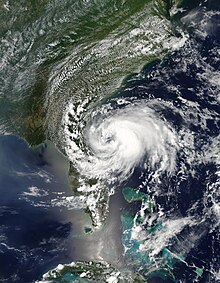Invest 97L likely to become a tropical storm next week, could threaten the U.S.
A tropical wave near 14°N 48°W, about 800 miles east of the Lesser Antilles Islands, is moving westward near 20 mph. This wave, designated Invest 97L by NHC yesterday, has seen a marked increase in its heavy thunderstorm activity this morning, but dry air to the north and west is slowing development. An impressive amount of large-scale spin is obvious in visible satellite loops, but the storm is at least a day away from forming a well-defined surface circulation. Ocean temperatures are about 28.5°C, about 2°C above the threshold needed to support a tropical storm, and wind shear is low, 5 - 10 knots.
The computer models have shown an unusual amount of agreement in developing 97L over the past few days, and all the ingredients seem to be in place for a tropical storm to form by Monday or Tuesday as 97L crosses the Northeast Caribbean. The atmosphere is expected to be moister over the Caribbean, wind shear will remain a low 5 - 10 knots, and sea surface temperatures will increase to near 29°C. The main impediment for development will likely be two-fold: too much dry, stable air, and proximity to land.
As seen in Figure 3, there has been an unusual amount of dry, stable air in the Atlantic this year, due to a combination of dry air from Africa, and upper-atmosphere dynamics creating large areas of sinking air that dry as they warm and approach the surface. This stable air has been largely responsible for the fact that none of our seven tropical storms so far this year has made it to hurricane strength, despite the presence of sea surface temperatures that are the 3rd warmest on record across the tropical Atlantic. Tropical Storm Emily in early August encountered problems with dry air when it crossed the Northeast Caribbean, and 97L may have similar difficulties.

Vertical instability of the atmosphere during 2011 in the Caribbean (left) and tropical Atlantic between the Lesser Antilles Islands and coast of Africa (right.) The instability is plotted in °C, as a difference in temperature from near the surface to the upper atmosphere. Thunderstorms grow much more readily when vertical instability is high. Observed vertical instability (blue line) has been much lower than the climatological average from previous years (black line), due to an unusual amount of dry air in the atmosphere, inhibiting tropical storm development this year. Image credit: NOAA/CIRA.
Encounters with land will be another potential major problem for 97L. Most of the computer models take 97L near or over Puerto Rico Sunday night, then very close to or over mountainous Hispaniola Monday night through Tuesday. It is unlikely that 97L will be stronger than a 55 mph tropical storm when it encounters these islands, and passage over the islands could severely disrupt the storm. However, if 97L takes a path just south or north of Hispaniola, the potential exists for the storm to intensify into a hurricane.
There will be moderate wind shear of 10 - 20 knots to the north of the islands early next week, so a path just to the south of the Dominican Republic and Haiti would be more likely to let 97L intensify into a hurricane. A west-northwest motion is likely for 97L through Wednesday, which would bring the storm to the vicinity of Jamaica-Central Cuba-the Central Bahamas on Wednesday. On Wednesday and Thursday, the models agree that a trough of low pressure will dip down over the Eastern U.S., which is likely to turn 97L to the north. The exact timing and strength of this trough varies considerably from model to model, and will be critical in determining where and when 97L will turn to the north. The best model for predicting the timing and strength of such troughs over the past two years has been the ECMWF (European Center model), and this model currently brings 97L into the Florida Keys on Thursday night next week. You can view ECMWF forecasts on our wundermap with the model layer turned on. The European Center does not permit public display of tropical storm positions from their hurricane tracking module of their model, so we are unable to put ECMWF forecasts on our computer model forecast page that plots positions from the other major models.
Remember that a 7-day forecast by even our best model will be off by an average of over 700 miles, so it is too early to tell what part of the U.S. might be most at risk from a strike by 97L. This weekend would be a good time to go over your hurricane preparedness.







